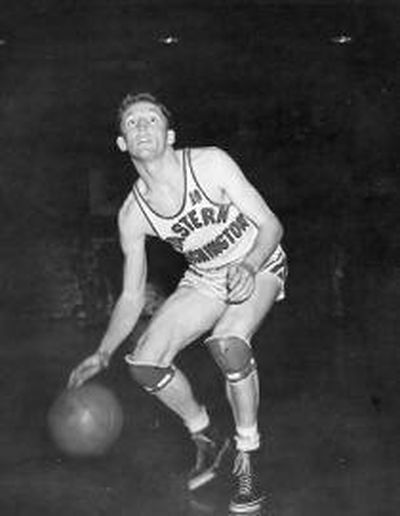Blanchette: Perrault did Eagles (and Cougs) proud

Eastern Washington’s athletic hall of fame welcomes another class Saturday, and it includes a man whose last collegiate feat was to quarterback Washington State to victory in the Apple Cup.
Possibly about now you’re thinking the Eagles need to revisit the idea of, you know, enrollment as part of the enshrinement criteria.
Not to worry.
Jack Perrault accomplished just as much or more in the red and white as he did in the crimson and gray, and, if anything, is overdue for the slice of recognition he’ll receive at EWU’s induction breakfast. In fact, Perrault may be one of the state’s most underheralded athletic successes – owing to a conspiracy of time, distance and mortality. And perhaps his own reticence for public relations.
“He never talked about it,” reported his son, Jack. “That generation didn’t do much bragging about what they’d done.”
And the senior Perrault never made it into the era of self-promotion. He died of a heart attack in 1974 at the age of 51, leaving his seven children to discover on their own that Dad was a pretty fair athlete – though every now and then as he’d coached them through youth sports a hint would emerge.
“I was in the sixth grade in Dallas and he was teaching me how to punt,” remembered Jack, the oldest of the Perrault kids. “He was probably 40 then and he could still just clobber the ball – he had a leg on him like crazy. He taught me and I was the only kid in the sixth grade who could punt a spiral.”
It was during that session that Perrault recalled for his son a punt he’d uncorked in an EWU game against the Washington State freshmen that traveled an even 100 yards from the spot where it left his foot just inside his own end zone to within a whisker of the Cougars’ goal line.
That was in 1941, the fall he arrived on the Eastern campus from Toppenish, where he’d made his reputation as a football player who dabbled in basketball. But when Eastern discontinued the sport after the 1942 season due to World War II, it opened up a whole new world for Perrault.
The war and post-war years were good to Eastern basketball. First under Bob Brumblay and then Red Reese, the Eagles made five trips to the NAIA tournament in six years. Perrault played on three of those, and in 1945, he poured in 507 points – the No. 2 mark nationally that year and an EWU record for 26 until Randy Buss topped it.
It was a pretty good year for scorers hereabouts. Down the road at WSU, Vince Hanson topped the nation with 582 points.
And the next fall, Perrault was a Cougar – but not to play basketball.
“I don’t know how that happened,” his son said. “There’s no telling what the eligibility rules were in that era.”
Well, the deciding factor likely was that Eastern had not yet resumed football – that wouldn’t happen until 1946 – while the Cougars started up after a two-year absence during the war.
Perrault, by the way, had missed serving after having been classified 4-F for the draft, though his brother can’t recall why.
“He was a horse, to be honest,” said Fred. “But I was 4-F in 1945, and then in 1950 I wasn’t – they got me for Korea.”
Amazingly, after two years off, Perrault was just as much an impact player in the Pacific Coast Conference as he was on the basketball court months before. He threw for a touchdown and ran for another in a season-opening blitz of Idaho. He had a late 35-yard touchdown pass to salvage a tie against Cal. And in the second meeting of the year against Washington – WSU’s schedule was a double round-robin against the Northwest schools – Perrault had the game’s only touchdown on an 11-yard run as the Cougs finished 6-2-1.
And then he was gone again – this time to Oklahoma to play for what at the time was the nation’s best basketball team, the Phillips 66ers. The NBA was barely a start-up at the time, and many of the top players found it more lucrative to take jobs with companies that fielded teams in the American and National Industrial leagues. The Oilers won the national AAU title each year Perrault played and he wound up making the trip to the 1948 Olympics in London as an alternate on the U.S. team.
He also wound up marrying a pretty office worker and dance instructor, and he and Mary Alice Perrault – still kicking at 94 – moved to Spokane to Waitsburg to Dallas before settling back in Oklahoma City to raise their family.
“I do remember seeing him play basketball,” his son said. “He had a distributorship with Phillips in Waitsburg and played on the town team. He could really shoot. Guys were double-teaming him 20 feet from the basket.”
Probably didn’t take much for him to shake free from those double teams. Jack Perrault could really get around.